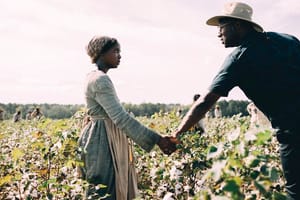
Cinematographer James Laxton remembers his first collaborations with director Barry Jenkins at Florida State University’s film program almost two decades ago, where their short films included “fun trickery” like putting a fish tank over the American flag.
“I don’t know that we’ve progressed all that much farther than that. I still think we’re putting fish tanks around things,” Laxton laughs.
Jenkins jokes: “Which is fuel for our haters.”
Their haters are few. Their 2016 collaboration Moonlight won the Oscar for Best Picture, and they earned more acclaim for the 2018 James Baldwin adaptation If Beale Street Could Talk. Their latest literary adaptation may be their most ambitious work to date: The Underground Railroad is a 10-part Amazon series based on Colson Whitehead’s Pulitzer Prize-winning 2016 novel of the same name. Shot across Georgia over 116 days, it follows a young woman named Cora (Thuso Mbedu) who flees slavery on a literal underground railroad, pursued by the ruthless Ridgeway (Joel Edgerton).
MovieMaker spoke with Jenkins and Laxton as they prepared for another huge undertaking: Disney’s Lion King sequel. They talked about pre-production inspirations for The Underground Railroad, why their shots-within-shots method is less manipulative than traditional edits, and how they approached violent sequences in a sensitive yet truthful manner.
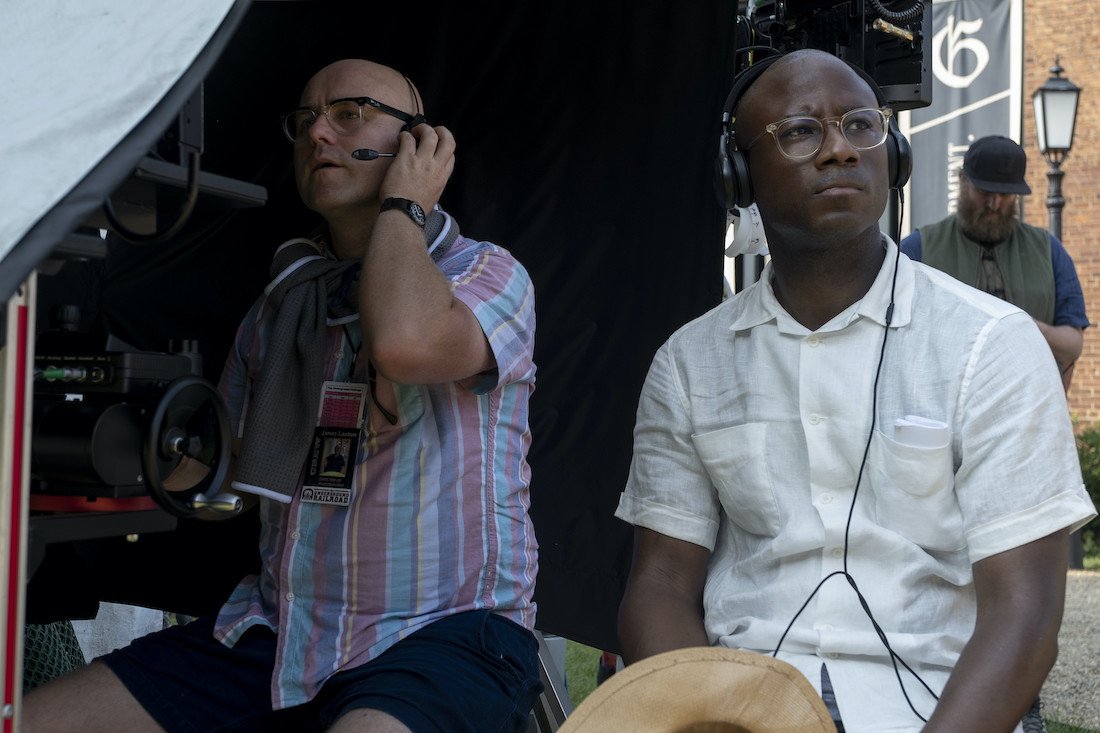
James Laxton and Barry Jenkins on the set of The Underground Railroad. Photos by Atsushi Nishijima/Amazon Studios.
Barry Jenkins: On this one, our pre-production was done in this elementary school in Savannah, Georgia, and there were all these different wings of the school. The school looked like single-story barracks, one of those like old-style schools, so there was an art wing, and then James had his big-ass office.
I used to love just walking into James’ office, because there’ll be all these deliveries, all these books showing up. And I would be like, “Yo, what’s this book? What’s that book?” James always makes his life a mood board as we’re going into a project.
While he’s doing that, I’m getting more familiar with the characters and with the locations. It’s kind of dope. But I never know why he grabs the books he grabs. Every film there’s a different photographer, and I’m like, “Yo, who’s that?” Who was the dude on this one?
James Laxton: Bill Henson was the guy that we looked at a lot for this series. Time is a funny thing right now for all of us, and I feel like time has a lot to do with how I ended up gravitating towards things that we all share together. … So it’s interesting to just find your way or stumble upon artists who inspire you, and all of a sudden, they end up having a deep impact on your work.
Jenkins: You use the word “stumble.” It’s one of those things, like, you know it when you see it. I love how there’s not the same place we go to. I think people assume we watch In the Mood for Love 80 times before we make anything, but that’s not the case. But I love that with every movie, every project, there’s this reset.
I fell in love with Kerry James Marshall while we were making Beale Street. It was too late to be a reference on Beale Street, but I remember that being the thing as we were making The Underground Railroad, to the point that when Cora picks up that hatchet beneath the bed in episode one, that’s Kerry James Marshall, “Portrait of Nat Turner with the Head of his Master.”
Laxton: On a daily basis, I’m an internet-scouring individual. I definitely wake up in the morning, and I’m looking at mood boards or I’m on Tumblr or whatever it is. I did that when I was in my twenties, and I’m still doing it today.
But there is something about just being surrounded by something physical. There is something about sharing books. Barry talked about coming to the office — that is important. That is only possible by sitting together, flipping through some physical stuff, and passing it back and forth.
Jenkins: It was so fluid where James and I would have these references in our head. We didn’t have to speak them or show them to anyone. So long as James and I were on the same page, everybody else was free to slip into this thing. Of all the things we’ve done, this is the most fluid. The images we ended up with were planned—because you can’t make something this long and not plan it — but on the day, it was so free, man. I mean, some of this shit James… whew, my God.
Laxton: Something that I always feel when working with you, Barry, we’re always on the edge of a razor—the difference between success and failure is always this thin margin.
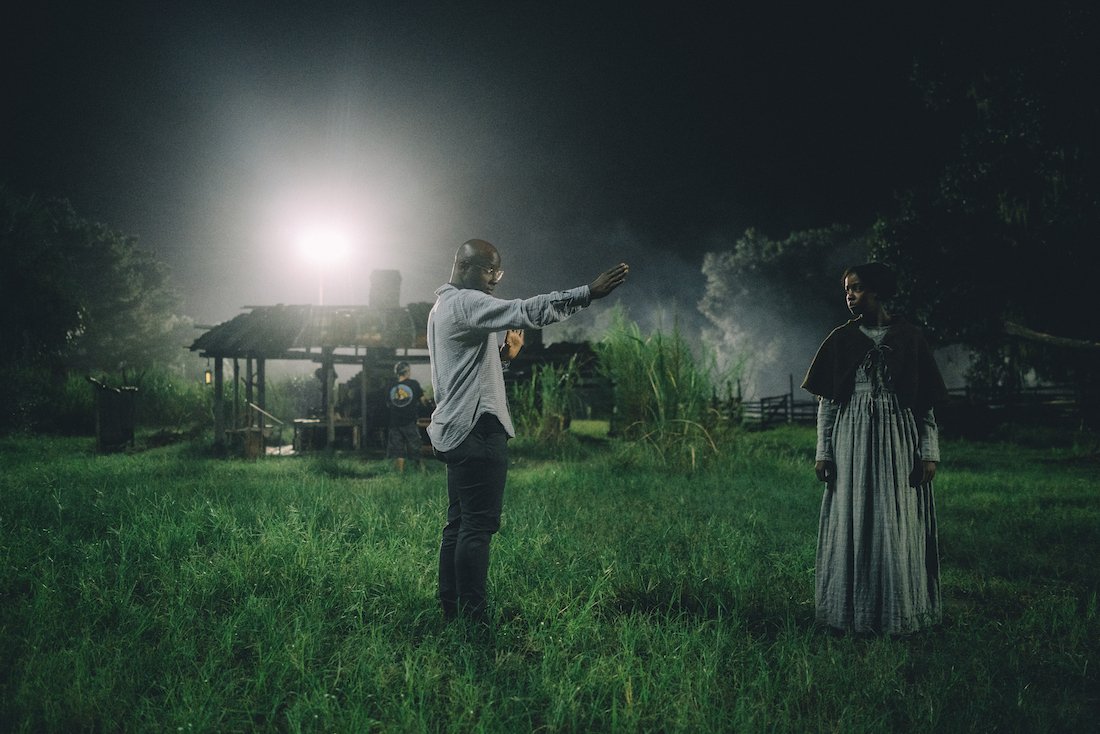
Barry Jenkins directs Thuso Mbedu in a scene of The Underground Railroad.
Avoiding Cuts
James Laxton: One of the first things in prep that I remember Barry saying many, many times over is he doesn’t want to cut. Clearly there’s many edits in the show. When a director says things so adamantly and so purposefully, there’s clearly something behind it. I would often think about what Barry is looking for when he talks about really wanting these things to play out.
I thought, there’s something going on in this story with the mythology and symbology behind this underground railroad train. And yet we were telling a very true story of American history and Cora’s journey on it. There’s something about not wanting the audience to feel like they’re being tricked, or missing something or not wanting some sort of cinematic trickery to be disguising something that wanted to feel true. So the fluidity behind some of these camera moves, I assume always came from that concept of wanting to present a perspective to our audience that didn’t feel like we were leaning too heavily into the symbology of this train, but actually seeing it physically, panning from a character to straight up a moving physical train that we really physically did. We were lucky enough to film some real trains and some real actors adjacent to them. There’s something really powerful about that, as opposed to cutting to some crazy visual effect.
Barry Jenkins: That’s it, man. I sometimes feel like when there’s a cut, I can feel the manipulation. And it’s all artifice — we’re creating all of it.
But, every edit where you cut to a new piece of media is a whole separate moment in time. So the longer you can extend a moment in time, the more grounded, the more visceral that is. James is absolutely right, we have this train that’s a personification of the actual Underground Railroad. When I was a kid, and I first heard the words, “Underground Railroad,” that shit felt real. I literally imagined Black people on trains underground that they built. So I wanted to find a way to get whatever extra artifice out of each shot that we could. With some of the stuff James and I have done over the last two films, there’s something moving — as opposed to using an edit to juxtapose an image, just like we do as human beings, where one piece of information draws your attention to another piece of information — and so instead of cutting to another shot, let’s create another shot with the camera.
We found a group of crew that were really adept at doing that with us. It just opened so many damn things. Because then when you do cut, it’s got meaning.
You cut eight times a second, each cut has less meaning. You cut one time every 30 seconds, hot damn, that shit’s got some meaning.
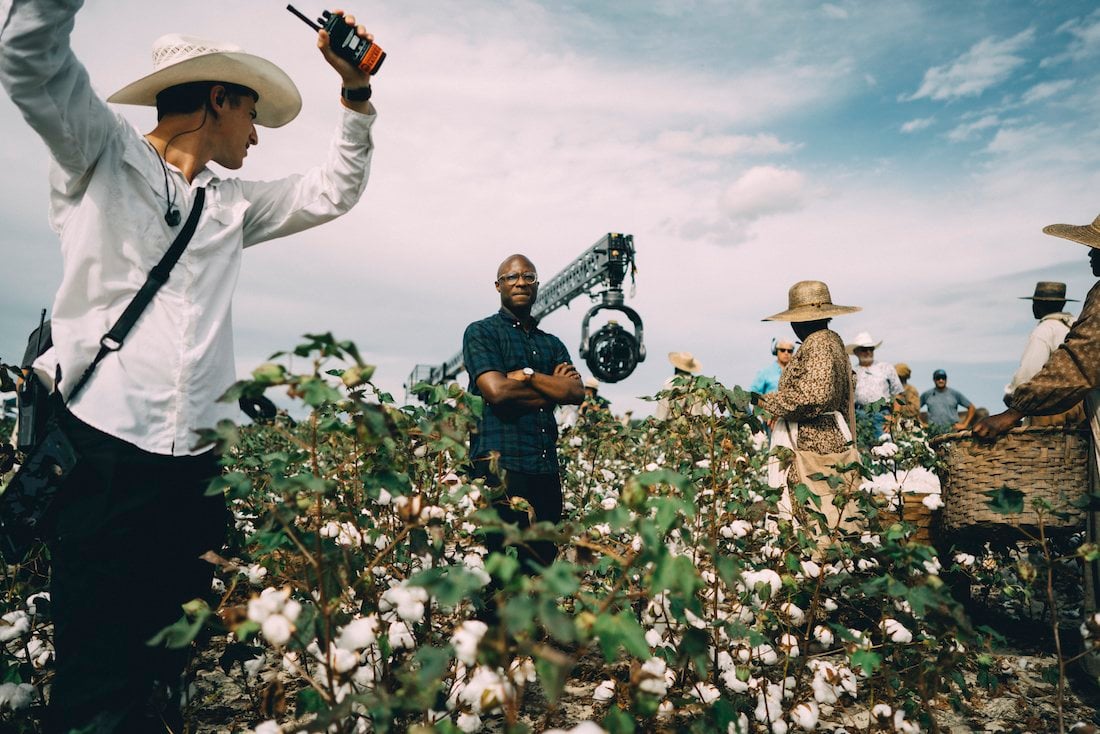
Barry Jenkins in Georgia on the set of The Underground Railroad. Main image (above): Barry Jenkins and Thuso Mbedu on the set of The Underground Railroad.
Shooting Violent Sequences
Barry Jenkins: This is where I give James so much credit, because there were some of these sequences where as an artist, I couldn’t be as present, because as a person, I was fucking going through it. My first priority had to be to make sure that the actors were safe, that they were taken care of.
In episode one, we cut to Cora and a young boy on a whipping post, and we come out really wide, super wide. Then the camera drifts and finds Caesar watching the scene play out. That was all the coverage we shot. Starting in that wide, it was so visceral, so intense. I thought, it doesn’t need to be any more intense than this. I don’t need to be on this close-up of this thing connecting with my actor’s back, whether it be effects or not. We shot the wide, and then, once we shot the wide, we were like, oh, let’s add a move where we come off the wide and we find Caesar. And that was that.
Now with the sequence where Big Anthony is tortured, this is where I’ll give James his props. As we got into that, I realized that I need to be there for the actor, Eli Everett. We had a plan, but once we got there filming the scene, the plan was in James’ hands — I kind of just turned that shit off. I was double checking that we were getting through the shots, but it was more important to me to manage the emotional mileage that was on the actor because he was actually suspended up there. And the harness was hurting him a bit, and I’m not a method director and I don’t require my actors to be method either. But it was painful. That was the only time we finished the scene, and I forgot that we had another scene to do after that, because I just walked off, man. I walked off into the middle of the field, and I just stood there by myself. I looked over, and James is setting up the next shot — I didn’t tell him shit. He set up the next shot and he adds a second shot because we got into a really good rhythm in this show, where we always had two cameras. The first camera would be something James and I agreed on, and then I’d be like, “Yo, give me some spice on the second camera.”
With those scenes, James and I discussed that we didn’t want to be gory, but we wanted to tell the truth. We were always looking for what is the most authentic, but not overly sensational, presentation that we can do. Let’s start there, and then we would feel if we needed more. With Big Anthony, we did shoot more coverage, but with that whipping scene, we just stayed wide. I never do this. Even though some of our shit plays out in not a lot of shots, we shoot more than we use in the edit. But in that case, I was like, “No, we are done.” And when you watch that shit in the show, it’s intense. It is intense, bro.
James Laxton: One thing that we try to do in general, but also applied to the violence here in this series, is to see things through characters’ perspectives. We felt if we could see even the violent moments from a perspective, it would actually mean something, as opposed to just objectifying some violent act.
Also read: Profile Director Timur Bekmambetov Tells Intimate Stories Onscreen — Computer Screens
Jenkins: Sometimes there are people on set who ask us, “Why are you making that choice?” It’s like, “I would explain it to you. But I’ve got to film 500 pages in 116 days, so I don’t have time.”
Laxton: That part’s definitely true.
Jenkins: And we’re still trying to film it the way we always film it, which means we have less time to get it right. So just let us do what we do. It kind of felt like that sometimes.
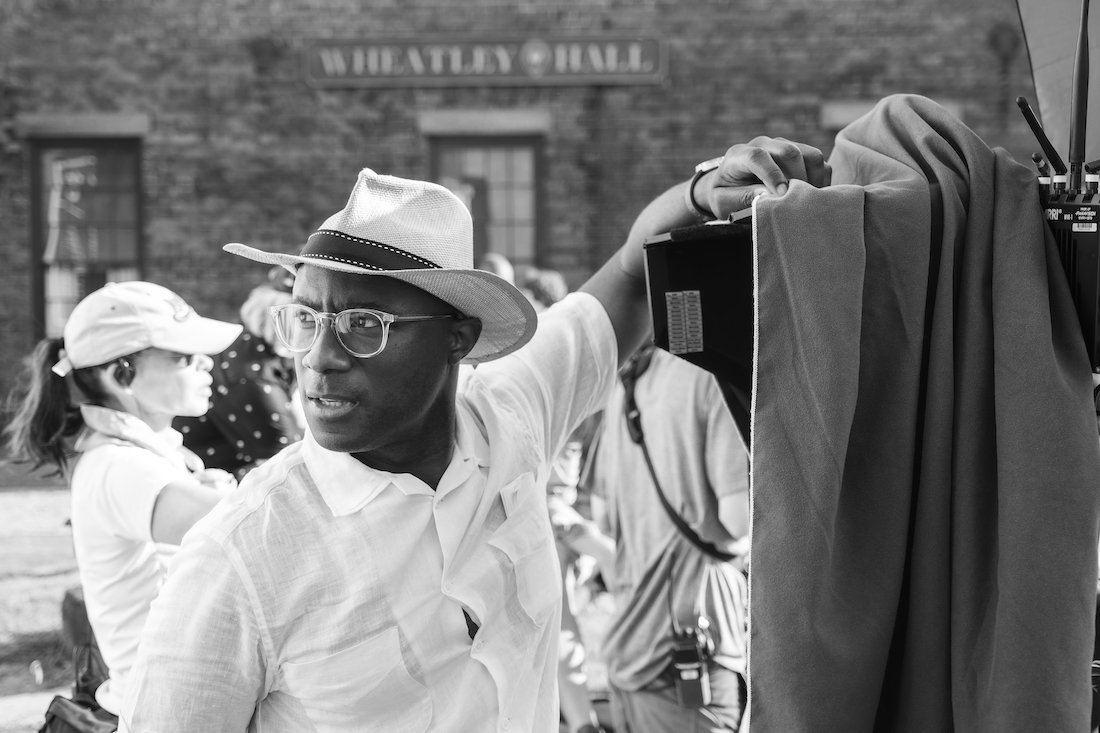
Barry Jenkins on the set of The Underground Railroad.
Laxton: It was a fast one. No doubt about it.
There’s one thing about shooting a TV series — you really get in the groove with your crew. On a film, you might have 30 days, 35 days on a low-budget movie. Maybe you have more in a big-budget movie, but this is 116 days of filming. At some point, you’re like a sports team just running down the field and you know where everyone’s gonna go.
Jenkins: It’s like rugby though, because you’re just tossing that thing around.
Laxton: But even rugby has a beautiful dance to it that applies.
Jenkins: That is true.
Laxton: And there’s something about that in terms of TV series filming — and I’m assuming the same is true for when you’re doing a big show and you have 200 days to film a feature as well — but we definitely felt the groove and there’s a lot we couldn’t have done without the crew. No doubt about it.
Jenkins: This is gonna be written, but I do want you to show how much we’re smiling even though — I don’t know about you — but this is the hardest thing I’ve ever done in my life.
Laxton: Absolutely.
Jenkins: And there were times where I thought it was going to kill me, I legitimately thought this is going to kill me. I’m not going to survive this.
There’s a reason that typically you don’t have the same director directing 500 pages of a show. It’s really hard to maintain a certain quality level, because you can’t focus on every minute detail. There’s just too much information. I don’t know how the fuck James did it. I walk to set, I have to see what’s there, and then try to find a performance with the actors. And all this fucking infrastructure, the lights, the trailers — all this shit James has got to be plotting out. Then on the day, he has to be present. It’s so difficult. What is it: Random access memory, where the computer works in the background? You’ve got to have 64mb going in the background at all times, in order to make this work. I thought it was gonna kill me, I really did.
Tech Box
Camera: ARRI ALEXA LF, ARRI ALEXA Mini LF
Lenses: Primo 70s and T Series Anamorphics
Color Grading: Alex Bickel at Color Creative with support of Technicolor
Lighting: Largely LEDs: ARRI SkyPanels, Astera Titan Tubes, LiteGear LiteMats
All episodes of The Underground Railroad, directed by Barry Jenkins and shot by James Laxton, will be available to stream on Amazon Prime Video on Friday.
Share:

